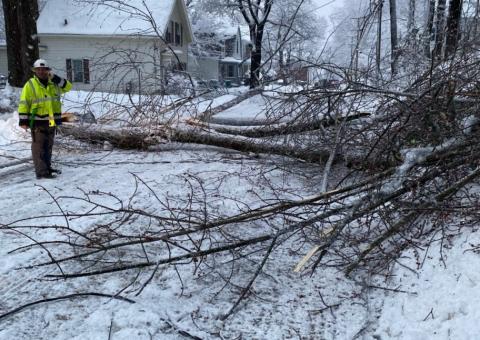When Damage Assessor Steven Moroni saw the extent of the damage from heavy, wet snow weighing down trees and power lines last month, he knew crews would have their work cut out for them.
When a major storm hits, Moroni trades in his standard 9-5 job as a Unitil Geographic Information System Analyst for his “storm role” of damage assessor. As a result, he and other assessors get a first-hand look at the damage in the field whenever bad weather strikes.
As soon as the power goes out, the first question that comes to mind for most customers is an obvious one: When will the lights come back on? It’s not always an easy question to answer, but that’s where damage assessors like Moroni come in.
“When we see a long-duration event like the snowstorms last month, part of an effective, efficient restoration effort is often a comprehensive assessment of the damage to the system. Until we can get a good damage assessment, we won’t have a complete picture as to what’s out there,” Unitil Media Relations Manager Alec O’Meara said. “This is why, when outages start stacking up out there, our map reverts to say ‘assessing’ in regards to estimated restoration time. We know seeing the word ‘assessing’ can be frustrating for our customers, but the reality of that moment is additional information is needed before we can give a more accurate estimate for customers.”
Damage assessment can be a lengthy process that begins with assessors being dispatched to impacted areas to survey the trouble spots. Their job is to relay critical details about the damage back to the company with the end-goal of deciding how crews will tackle what can sometimes be an extensive multi-day restoration effort and establishing accurate estimated times of power restoration for customers.
While crews are restoring power where possible and working with first responders throughout the event, Unitil must wait until the hazardous conditions created by a storm end before assessors can begin estimating how long it will take to restore all customers. Once the storm wraps up, crews can then get a handle on the full extent of the damage and the repairs that will be needed.
Once in the field, damage assessors must look at the entire system to determine all of the jobs that need to be completed. With that information in hand, Unitil then looks at the number of crews that it has available and determines the number of hours that it will likely take to complete each job. After the calculation is made, the company is able to provide a clear estimate of when power should be restored. The information is then shared with customers and estimated times of restoration (ETRs) are added to the Unitil Outage Map.
During the storm on Jan. 23 that impacted nearly 30,000 customers in Unitil’s New Hampshire and Massachusetts territories, damage assessors encountered numerous limbs on wires, broken utility poles, downed trees and wires and other problems. Like in many larger storms, simply reaching affected areas can be challenging because of blocked roads and other debris.
“We have to be mindful of our surroundings and of our own safety, too. We’re out there near all of these potentially downed wires,” Moroni said of the assessment work. “Luckily we were all fine, but we have to make sure we tread carefully. There are just a lot of things that we have to be aware of as we’re doing this work and try to make sure we’re as safe as possible while we’re trying to get as much information as possible over to the storm team.”
Once complete, a damage assessment can also help in other ways with a restoration effort. Crews with knowledge of what is awaiting them at a specific location will arrive with specialized tools and supplies, and worksheets can be built to ensure the outages impacting the most customers are prioritized.
“At the end of the day, the goal is always to find a way to bring everyone back online as safely and as quickly as possible,” O’Meara said. “Tools like damage assessment can not only help us update the outage map with the restoration information our customers need for planning, it can help us find efficiencies that will allow our team to work smarter and faster.”
Photo caption: Parts of Unitil's service territory experienced extensive tree damage during a winter storm that hit the region on Jan. 23.


